Marketing Intelligence Report: Consumer Behavior at Marks & Spencer
VerifiedAdded on 2020/01/16
|21
|5085
|285
Report
AI Summary
This report provides a comprehensive analysis of Marks & Spencer's (M&S) marketing intelligence, focusing on consumer behavior, market research, and brand loyalty. It begins by outlining the stages of consumer decision-making and explores various buyer behavior theories, including diffusion of innovation, buyer stimuli models, and cultural theory. The report then delves into the factors influencing consumer purchasing decisions, such as personal, social, cultural, and psychological aspects. Furthermore, it examines brand loyalty, corporate image, and the relationship between repeat purchasing and brand association. A significant portion of the report is dedicated to market research, detailing objectives, techniques (primary and secondary), and the importance of validity and reliability. It includes a proposed market research plan. Finally, the report analyzes M&S's market size trends, identifies key competitors, and conducts a SWOT analysis to evaluate opportunities and threats. The report concludes by identifying techniques to examine consumer responses and includes a customer satisfaction survey, reviewing its success to provide actionable recommendations for M&S.

MARKETING INTELLIGENCE
Paraphrase This Document
Need a fresh take? Get an instant paraphrase of this document with our AI Paraphraser
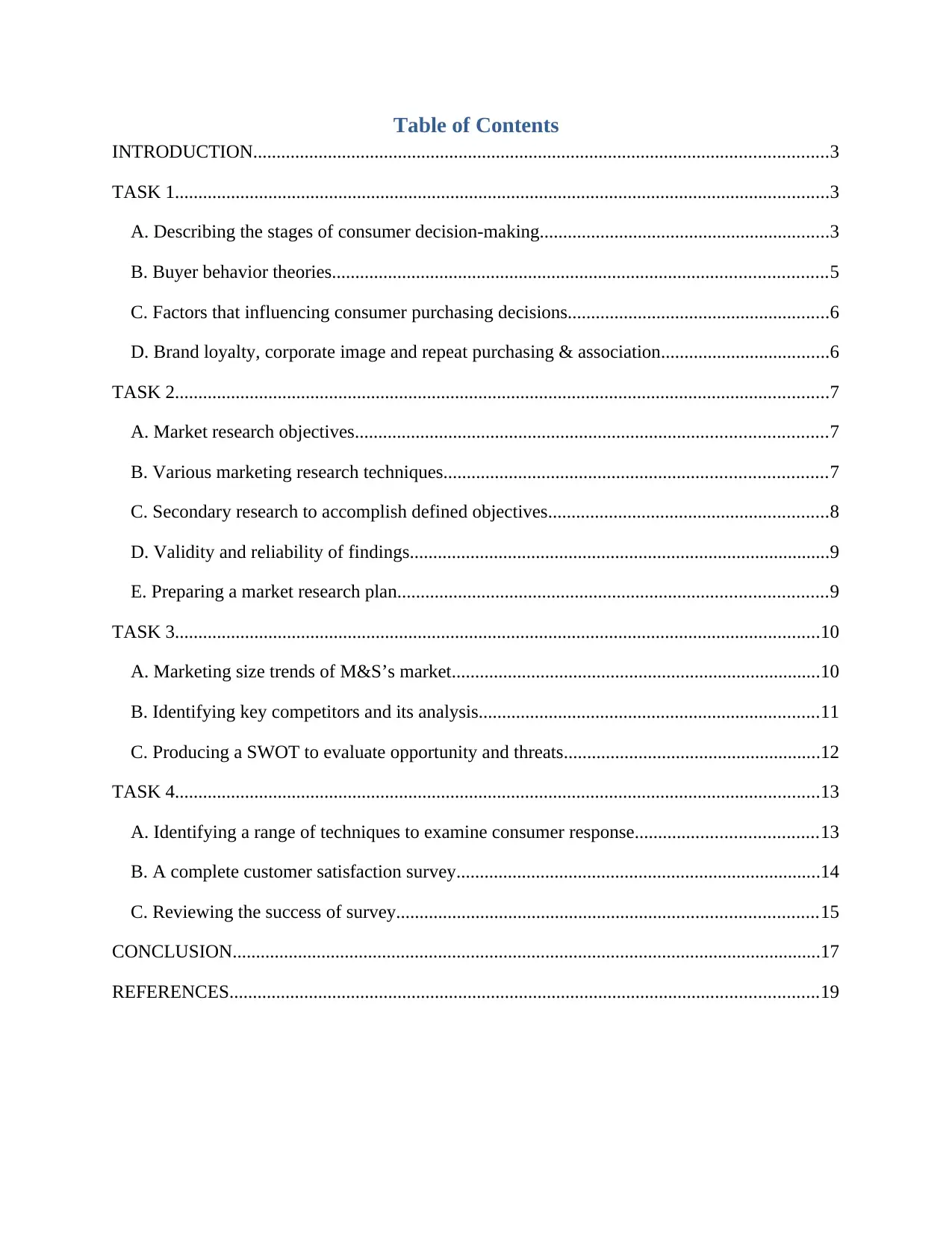
Table of Contents
INTRODUCTION...........................................................................................................................3
TASK 1............................................................................................................................................3
A. Describing the stages of consumer decision-making..............................................................3
B. Buyer behavior theories..........................................................................................................5
C. Factors that influencing consumer purchasing decisions........................................................6
D. Brand loyalty, corporate image and repeat purchasing & association....................................6
TASK 2............................................................................................................................................7
A. Market research objectives.....................................................................................................7
B. Various marketing research techniques..................................................................................7
C. Secondary research to accomplish defined objectives............................................................8
D. Validity and reliability of findings..........................................................................................9
E. Preparing a market research plan............................................................................................9
TASK 3..........................................................................................................................................10
A. Marketing size trends of M&S’s market...............................................................................10
B. Identifying key competitors and its analysis.........................................................................11
C. Producing a SWOT to evaluate opportunity and threats.......................................................12
TASK 4..........................................................................................................................................13
A. Identifying a range of techniques to examine consumer response.......................................13
B. A complete customer satisfaction survey..............................................................................14
C. Reviewing the success of survey..........................................................................................15
CONCLUSION..............................................................................................................................17
REFERENCES..............................................................................................................................19
INTRODUCTION...........................................................................................................................3
TASK 1............................................................................................................................................3
A. Describing the stages of consumer decision-making..............................................................3
B. Buyer behavior theories..........................................................................................................5
C. Factors that influencing consumer purchasing decisions........................................................6
D. Brand loyalty, corporate image and repeat purchasing & association....................................6
TASK 2............................................................................................................................................7
A. Market research objectives.....................................................................................................7
B. Various marketing research techniques..................................................................................7
C. Secondary research to accomplish defined objectives............................................................8
D. Validity and reliability of findings..........................................................................................9
E. Preparing a market research plan............................................................................................9
TASK 3..........................................................................................................................................10
A. Marketing size trends of M&S’s market...............................................................................10
B. Identifying key competitors and its analysis.........................................................................11
C. Producing a SWOT to evaluate opportunity and threats.......................................................12
TASK 4..........................................................................................................................................13
A. Identifying a range of techniques to examine consumer response.......................................13
B. A complete customer satisfaction survey..............................................................................14
C. Reviewing the success of survey..........................................................................................15
CONCLUSION..............................................................................................................................17
REFERENCES..............................................................................................................................19
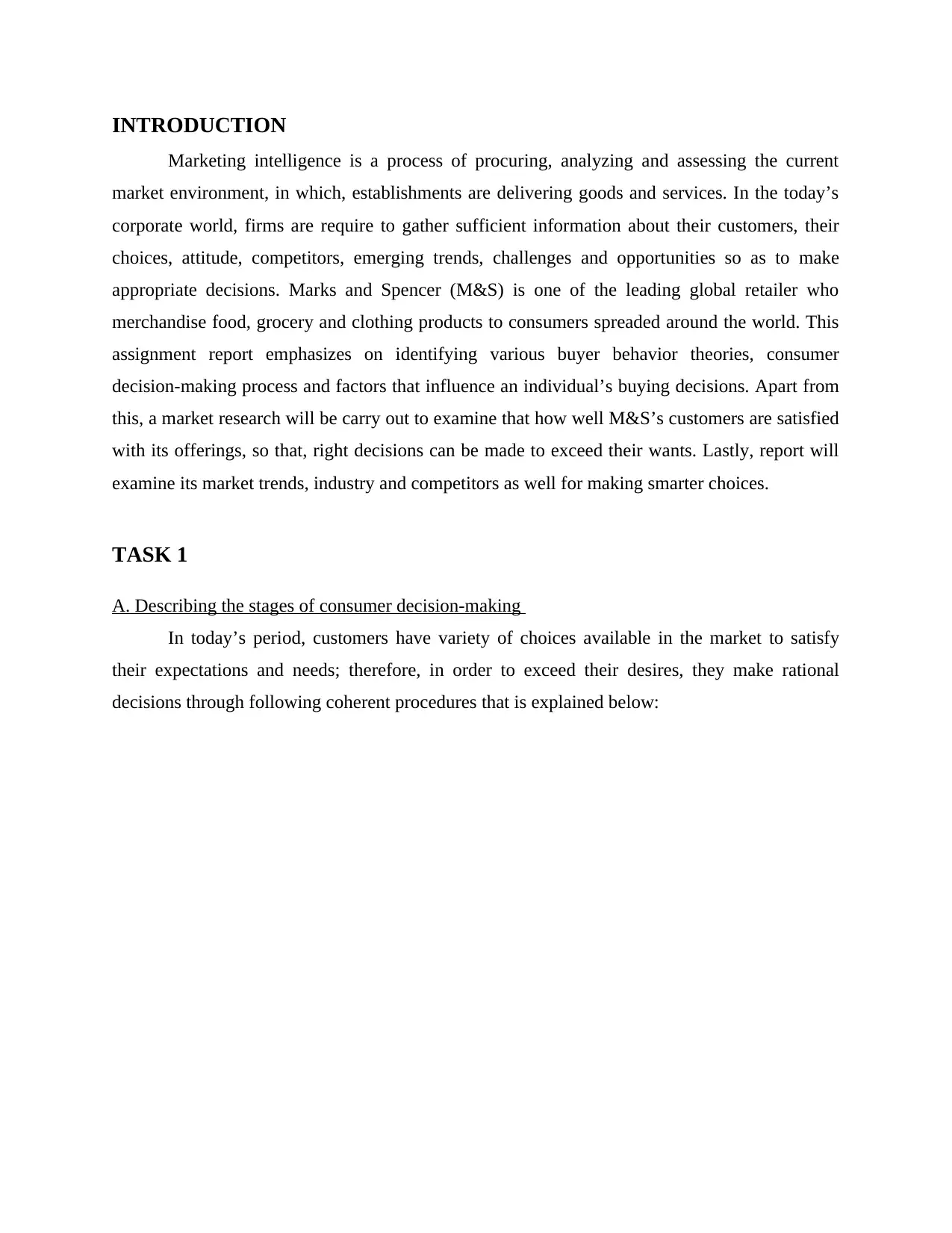
INTRODUCTION
Marketing intelligence is a process of procuring, analyzing and assessing the current
market environment, in which, establishments are delivering goods and services. In the today’s
corporate world, firms are require to gather sufficient information about their customers, their
choices, attitude, competitors, emerging trends, challenges and opportunities so as to make
appropriate decisions. Marks and Spencer (M&S) is one of the leading global retailer who
merchandise food, grocery and clothing products to consumers spreaded around the world. This
assignment report emphasizes on identifying various buyer behavior theories, consumer
decision-making process and factors that influence an individual’s buying decisions. Apart from
this, a market research will be carry out to examine that how well M&S’s customers are satisfied
with its offerings, so that, right decisions can be made to exceed their wants. Lastly, report will
examine its market trends, industry and competitors as well for making smarter choices.
TASK 1
A. Describing the stages of consumer decision-making
In today’s period, customers have variety of choices available in the market to satisfy
their expectations and needs; therefore, in order to exceed their desires, they make rational
decisions through following coherent procedures that is explained below:
Marketing intelligence is a process of procuring, analyzing and assessing the current
market environment, in which, establishments are delivering goods and services. In the today’s
corporate world, firms are require to gather sufficient information about their customers, their
choices, attitude, competitors, emerging trends, challenges and opportunities so as to make
appropriate decisions. Marks and Spencer (M&S) is one of the leading global retailer who
merchandise food, grocery and clothing products to consumers spreaded around the world. This
assignment report emphasizes on identifying various buyer behavior theories, consumer
decision-making process and factors that influence an individual’s buying decisions. Apart from
this, a market research will be carry out to examine that how well M&S’s customers are satisfied
with its offerings, so that, right decisions can be made to exceed their wants. Lastly, report will
examine its market trends, industry and competitors as well for making smarter choices.
TASK 1
A. Describing the stages of consumer decision-making
In today’s period, customers have variety of choices available in the market to satisfy
their expectations and needs; therefore, in order to exceed their desires, they make rational
decisions through following coherent procedures that is explained below:
⊘ This is a preview!⊘
Do you want full access?
Subscribe today to unlock all pages.

Trusted by 1+ million students worldwide
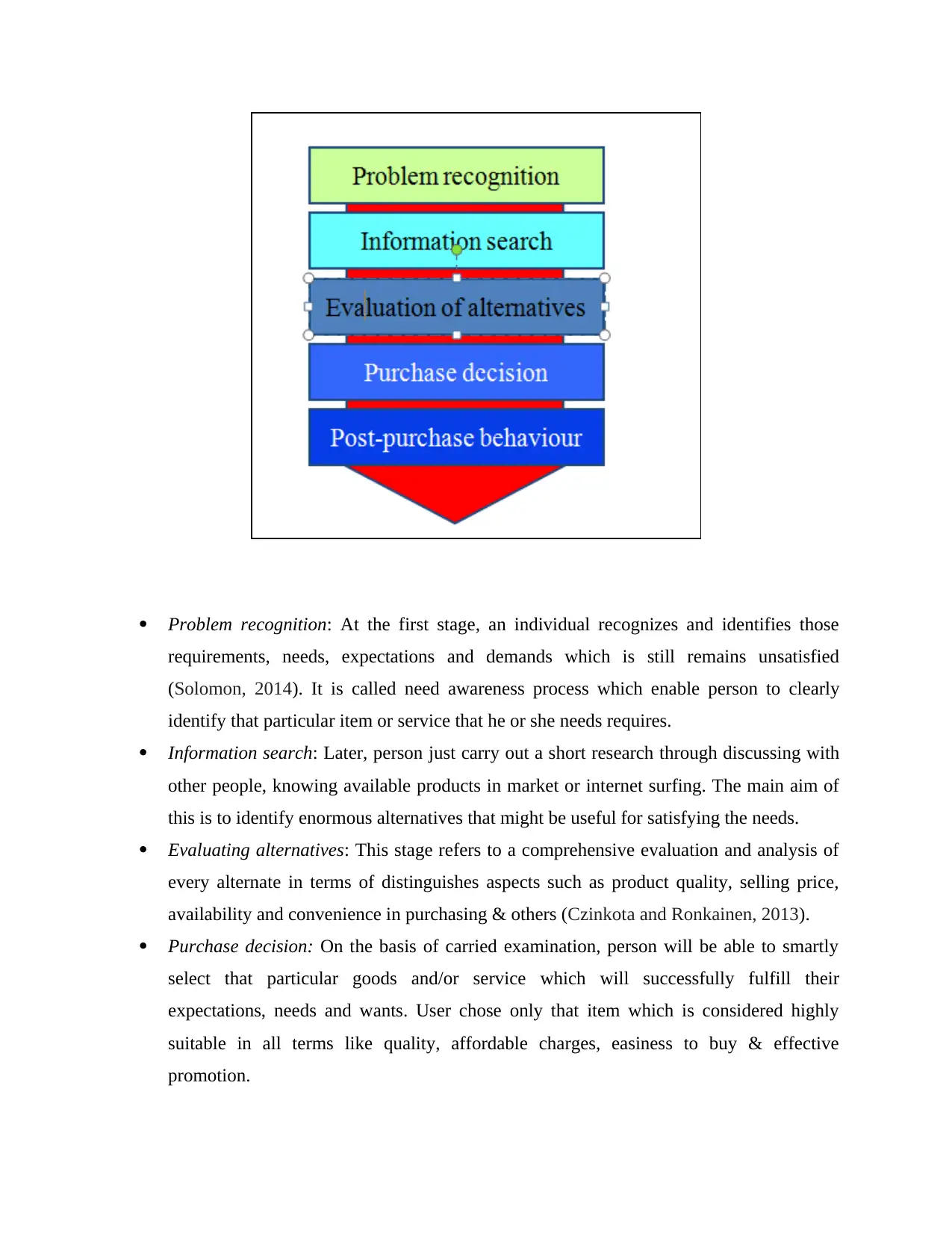
Problem recognition: At the first stage, an individual recognizes and identifies those
requirements, needs, expectations and demands which is still remains unsatisfied
(Solomon, 2014). It is called need awareness process which enable person to clearly
identify that particular item or service that he or she needs requires.
Information search: Later, person just carry out a short research through discussing with
other people, knowing available products in market or internet surfing. The main aim of
this is to identify enormous alternatives that might be useful for satisfying the needs.
Evaluating alternatives: This stage refers to a comprehensive evaluation and analysis of
every alternate in terms of distinguishes aspects such as product quality, selling price,
availability and convenience in purchasing & others (Czinkota and Ronkainen, 2013).
Purchase decision: On the basis of carried examination, person will be able to smartly
select that particular goods and/or service which will successfully fulfill their
expectations, needs and wants. User chose only that item which is considered highly
suitable in all terms like quality, affordable charges, easiness to buy & effective
promotion.
requirements, needs, expectations and demands which is still remains unsatisfied
(Solomon, 2014). It is called need awareness process which enable person to clearly
identify that particular item or service that he or she needs requires.
Information search: Later, person just carry out a short research through discussing with
other people, knowing available products in market or internet surfing. The main aim of
this is to identify enormous alternatives that might be useful for satisfying the needs.
Evaluating alternatives: This stage refers to a comprehensive evaluation and analysis of
every alternate in terms of distinguishes aspects such as product quality, selling price,
availability and convenience in purchasing & others (Czinkota and Ronkainen, 2013).
Purchase decision: On the basis of carried examination, person will be able to smartly
select that particular goods and/or service which will successfully fulfill their
expectations, needs and wants. User chose only that item which is considered highly
suitable in all terms like quality, affordable charges, easiness to buy & effective
promotion.
Paraphrase This Document
Need a fresh take? Get an instant paraphrase of this document with our AI Paraphraser

Post-buying behavior: Purchase is not the end of decision, after real consumption of item,
user examine their satisfaction level to assess post-purchase decisions (Brindha and
Parameswaran, 2017). This is the ending stage, in which, they compare their desirable
expectations with the actual utility gained through consumption to examine that to what
extent goods adequately meet the unsatisfied needs.
M&S needs to excelled and analyzed the above mentioned process to recognize
actual needs of clients and produce goods and services keeping into account user
specification to retain competitive position in the market place.
B. Buyer behavior theories
Presently, there are multiple approaches of individual’s buying behavior that needs to be
analyzed by M&S to identify the ways that how they can persuade or influence clients to buy
their offerings, explained underneath:
Diffusion of innovation: As its name, the theory explains that each offering of M&S
flows through a defined phase such as introduction, growth, maturity & decline. At, growth
stage, sales grow at faster rate whilst maturity indicate enough satisfaction and after it, demand
shows downward slope results in less sales (Valente and et.al., 2015). This is the stage requiring
M&S to adopt innovative business practices to launch and bring a new item in the market that is
not yet offering by rival firms. Now-a-days, establishments like M&S spend heavy expenditures
on research & a development (R&D) operation to design new items for exceeding clients wants
and desires to uphold.
Buyer stimuli model: According to this concept, individual’s buying decisions is
influenced through both the marketing (product, price, place & promotion) & other external
factors like economical, cultural, political & many others (Strauss, 2016). All the marketing
components can be controlled by M&S and have strength to change buyer response regarding
product selection, choice of retailer, buying time & spending amount. For instance, suppose
M&S’s charges affordable or reasonable charges for the delivery of clothing goods then it will be
able to attract crowded audiences at the business which drive more sales and return as well.
user examine their satisfaction level to assess post-purchase decisions (Brindha and
Parameswaran, 2017). This is the ending stage, in which, they compare their desirable
expectations with the actual utility gained through consumption to examine that to what
extent goods adequately meet the unsatisfied needs.
M&S needs to excelled and analyzed the above mentioned process to recognize
actual needs of clients and produce goods and services keeping into account user
specification to retain competitive position in the market place.
B. Buyer behavior theories
Presently, there are multiple approaches of individual’s buying behavior that needs to be
analyzed by M&S to identify the ways that how they can persuade or influence clients to buy
their offerings, explained underneath:
Diffusion of innovation: As its name, the theory explains that each offering of M&S
flows through a defined phase such as introduction, growth, maturity & decline. At, growth
stage, sales grow at faster rate whilst maturity indicate enough satisfaction and after it, demand
shows downward slope results in less sales (Valente and et.al., 2015). This is the stage requiring
M&S to adopt innovative business practices to launch and bring a new item in the market that is
not yet offering by rival firms. Now-a-days, establishments like M&S spend heavy expenditures
on research & a development (R&D) operation to design new items for exceeding clients wants
and desires to uphold.
Buyer stimuli model: According to this concept, individual’s buying decisions is
influenced through both the marketing (product, price, place & promotion) & other external
factors like economical, cultural, political & many others (Strauss, 2016). All the marketing
components can be controlled by M&S and have strength to change buyer response regarding
product selection, choice of retailer, buying time & spending amount. For instance, suppose
M&S’s charges affordable or reasonable charges for the delivery of clothing goods then it will be
able to attract crowded audiences at the business which drive more sales and return as well.

Cultural theory: Culture, belief, society’s values, learning that an individual gained from
the community also influence buyer. In these respect, education, economic situation, earnings,
opinion leaders have a strong influence over other members buying decisions.
C. Factors that influencing consumer purchasing decisions
Personal: An individual’s own desires, expectations, needs, income level, age,
occupation, gender, interest, choices, personality, self-concept, willingness & so on influence
them when decides to buy a product (Lysonski and Durvasula, 2013). For instance, an employed
people earn less so demand goods at reasonable charges whilst a businessman usually prefers
costly items due to better affordability. In M&S, younger people often demands designer & new
clothing items whereas an old-aged people prefer comfortability more.
Social: Status in society, reference & aspiration group members, family members also
influence on an individual’s buying decisions either directly or indirectly (Lee, Lee and Kim,
2015). A high class society will prefer luxurious home products from M&S whereas a middle
class family can afford products at reasonable charges.
Cultural: People’s value, belief, religion, cultural pattern, subculture & others also
influence them whether to prefer an item or not (Saleh, Ali and Julian, 2014). For instance,
opinion leader have excellent knowledge and well-personality which affect others decisions.
Psychological: Motivation hierarchy of Maslow, learning, inspiration and attitude, belief
are known as psychological components that encourage and inspire an individual to make buy of
the goods.
D. Brand loyalty, corporate image and repeat purchasing & association
Brand equity/loyalty: It is regarded as the perception or current views of target audiences
towards M&S (Fatema, Azad and Masum, 2015). Alternatively, a unique bundle of association
& positive belief in the mind of M&S’s clients towards the M&S’s product quality, service &
others is called brand loyalty.
Corporate reputation/image: It represents that how consumer perceives or considers
organization, means psychological picture in the globalized consumers is termed as corporation
image (Horner and Swarbrooke, 2016).
the community also influence buyer. In these respect, education, economic situation, earnings,
opinion leaders have a strong influence over other members buying decisions.
C. Factors that influencing consumer purchasing decisions
Personal: An individual’s own desires, expectations, needs, income level, age,
occupation, gender, interest, choices, personality, self-concept, willingness & so on influence
them when decides to buy a product (Lysonski and Durvasula, 2013). For instance, an employed
people earn less so demand goods at reasonable charges whilst a businessman usually prefers
costly items due to better affordability. In M&S, younger people often demands designer & new
clothing items whereas an old-aged people prefer comfortability more.
Social: Status in society, reference & aspiration group members, family members also
influence on an individual’s buying decisions either directly or indirectly (Lee, Lee and Kim,
2015). A high class society will prefer luxurious home products from M&S whereas a middle
class family can afford products at reasonable charges.
Cultural: People’s value, belief, religion, cultural pattern, subculture & others also
influence them whether to prefer an item or not (Saleh, Ali and Julian, 2014). For instance,
opinion leader have excellent knowledge and well-personality which affect others decisions.
Psychological: Motivation hierarchy of Maslow, learning, inspiration and attitude, belief
are known as psychological components that encourage and inspire an individual to make buy of
the goods.
D. Brand loyalty, corporate image and repeat purchasing & association
Brand equity/loyalty: It is regarded as the perception or current views of target audiences
towards M&S (Fatema, Azad and Masum, 2015). Alternatively, a unique bundle of association
& positive belief in the mind of M&S’s clients towards the M&S’s product quality, service &
others is called brand loyalty.
Corporate reputation/image: It represents that how consumer perceives or considers
organization, means psychological picture in the globalized consumers is termed as corporation
image (Horner and Swarbrooke, 2016).
⊘ This is a preview!⊘
Do you want full access?
Subscribe today to unlock all pages.

Trusted by 1+ million students worldwide
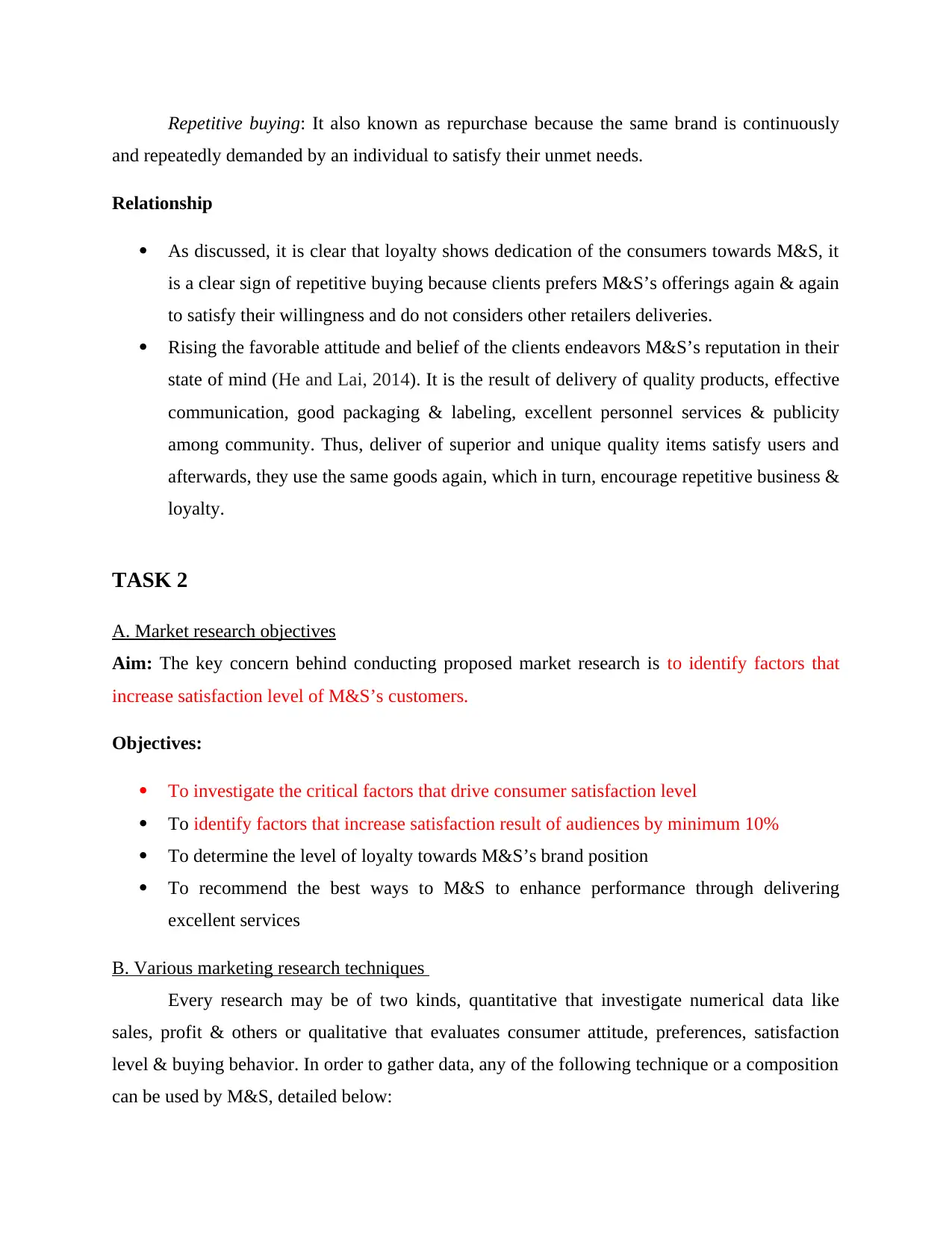
Repetitive buying: It also known as repurchase because the same brand is continuously
and repeatedly demanded by an individual to satisfy their unmet needs.
Relationship
As discussed, it is clear that loyalty shows dedication of the consumers towards M&S, it
is a clear sign of repetitive buying because clients prefers M&S’s offerings again & again
to satisfy their willingness and do not considers other retailers deliveries.
Rising the favorable attitude and belief of the clients endeavors M&S’s reputation in their
state of mind (He and Lai, 2014). It is the result of delivery of quality products, effective
communication, good packaging & labeling, excellent personnel services & publicity
among community. Thus, deliver of superior and unique quality items satisfy users and
afterwards, they use the same goods again, which in turn, encourage repetitive business &
loyalty.
TASK 2
A. Market research objectives
Aim: The key concern behind conducting proposed market research is to identify factors that
increase satisfaction level of M&S’s customers.
Objectives:
To investigate the critical factors that drive consumer satisfaction level
To identify factors that increase satisfaction result of audiences by minimum 10%
To determine the level of loyalty towards M&S’s brand position
To recommend the best ways to M&S to enhance performance through delivering
excellent services
B. Various marketing research techniques
Every research may be of two kinds, quantitative that investigate numerical data like
sales, profit & others or qualitative that evaluates consumer attitude, preferences, satisfaction
level & buying behavior. In order to gather data, any of the following technique or a composition
can be used by M&S, detailed below:
and repeatedly demanded by an individual to satisfy their unmet needs.
Relationship
As discussed, it is clear that loyalty shows dedication of the consumers towards M&S, it
is a clear sign of repetitive buying because clients prefers M&S’s offerings again & again
to satisfy their willingness and do not considers other retailers deliveries.
Rising the favorable attitude and belief of the clients endeavors M&S’s reputation in their
state of mind (He and Lai, 2014). It is the result of delivery of quality products, effective
communication, good packaging & labeling, excellent personnel services & publicity
among community. Thus, deliver of superior and unique quality items satisfy users and
afterwards, they use the same goods again, which in turn, encourage repetitive business &
loyalty.
TASK 2
A. Market research objectives
Aim: The key concern behind conducting proposed market research is to identify factors that
increase satisfaction level of M&S’s customers.
Objectives:
To investigate the critical factors that drive consumer satisfaction level
To identify factors that increase satisfaction result of audiences by minimum 10%
To determine the level of loyalty towards M&S’s brand position
To recommend the best ways to M&S to enhance performance through delivering
excellent services
B. Various marketing research techniques
Every research may be of two kinds, quantitative that investigate numerical data like
sales, profit & others or qualitative that evaluates consumer attitude, preferences, satisfaction
level & buying behavior. In order to gather data, any of the following technique or a composition
can be used by M&S, detailed below:
Paraphrase This Document
Need a fresh take? Get an instant paraphrase of this document with our AI Paraphraser

Primary research: In this, investigator needs to conduct an original survey often used to
gather specific information, can be collected from following methods:
Interview: It is typically used to gather needed information through asking questions to
the regular or permanent visitors (Fowler Jr, 2013). M&S’s marketers can conduct interview
either face to face or telephonic to gather sufficient set of data to investigate the satisfaction
level.
Survey: In this, marketers can design a well-structured questionnaire comprising variety
of questions, open-ended, dichotomous, multiple-choice, likert scale & so on (McQuarrie, 2015).
There are 2 ways available that are field survey that requires physical meeting and online survey
through using web.
Observation: This is just as an inspection, in which, M&S’s marketing managers can
observe their audiences either by visiting physically at stores or through CCTV cameras. It
enable them to analyze how user behave and demand goods when visit retail store.
C. Secondary research to accomplish defined objectives
Secondary research: In this, M&S’s marketing executives can gather and collect that
information that already has been generated, processed and stored by other scholar. It is also of
great significance and thoroughly and in-depth examination assists firm to generate ideal
information for accomplishing the set targets (McGivern, 2013). Regards to cited firm, it can
obtain significant amount of data through following resources, presented below:
Internal data base
Financial statements such as profitability statement and balance sheet
End-user feedbacks
Market research reports of UK retail industry (Babin and Zikmund, 2015)
European directory on marketing operations
Trade association published reports
Internet source
Historical peer-reviews and articles
Others
gather specific information, can be collected from following methods:
Interview: It is typically used to gather needed information through asking questions to
the regular or permanent visitors (Fowler Jr, 2013). M&S’s marketers can conduct interview
either face to face or telephonic to gather sufficient set of data to investigate the satisfaction
level.
Survey: In this, marketers can design a well-structured questionnaire comprising variety
of questions, open-ended, dichotomous, multiple-choice, likert scale & so on (McQuarrie, 2015).
There are 2 ways available that are field survey that requires physical meeting and online survey
through using web.
Observation: This is just as an inspection, in which, M&S’s marketing managers can
observe their audiences either by visiting physically at stores or through CCTV cameras. It
enable them to analyze how user behave and demand goods when visit retail store.
C. Secondary research to accomplish defined objectives
Secondary research: In this, M&S’s marketing executives can gather and collect that
information that already has been generated, processed and stored by other scholar. It is also of
great significance and thoroughly and in-depth examination assists firm to generate ideal
information for accomplishing the set targets (McGivern, 2013). Regards to cited firm, it can
obtain significant amount of data through following resources, presented below:
Internal data base
Financial statements such as profitability statement and balance sheet
End-user feedbacks
Market research reports of UK retail industry (Babin and Zikmund, 2015)
European directory on marketing operations
Trade association published reports
Internet source
Historical peer-reviews and articles
Others
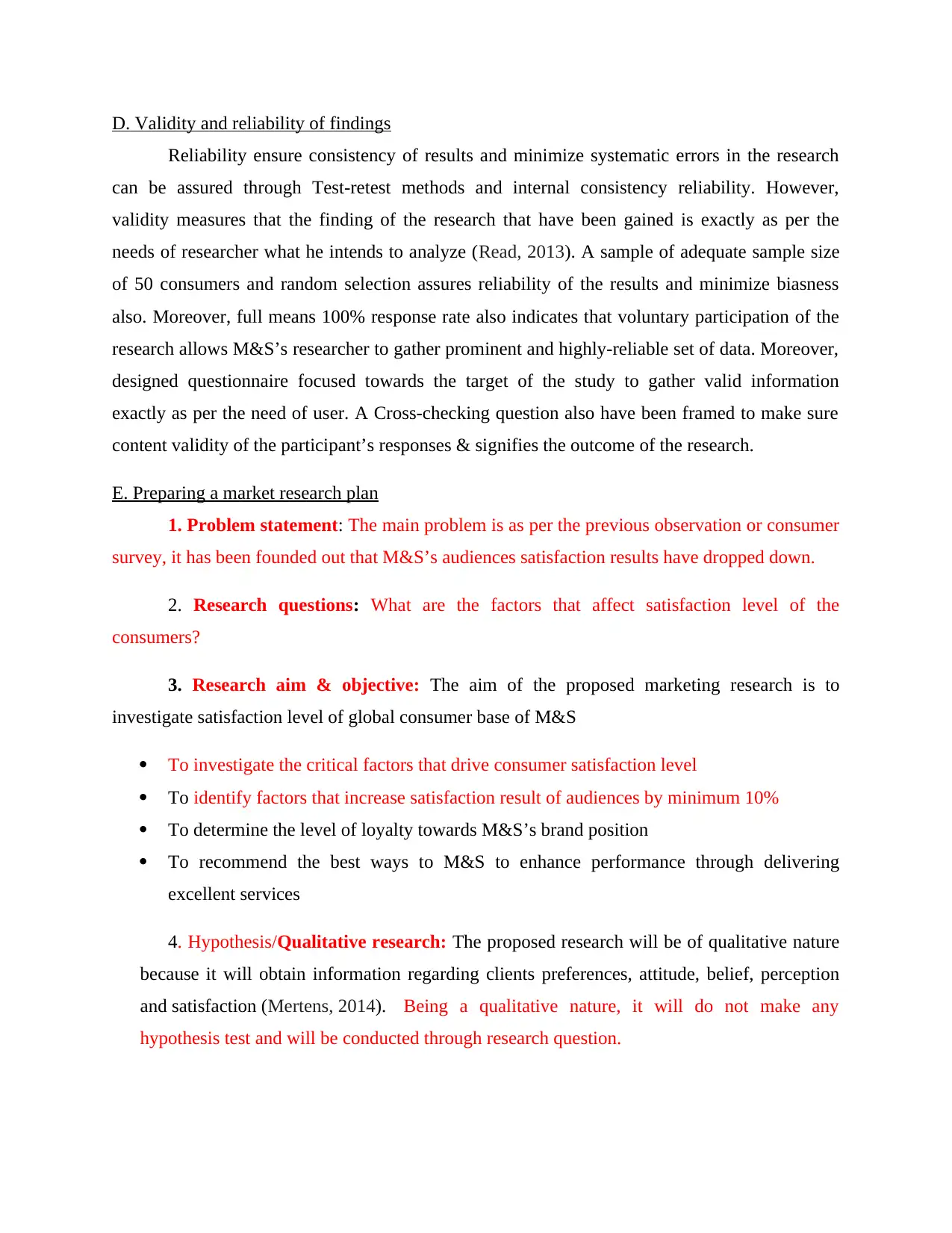
D. Validity and reliability of findings
Reliability ensure consistency of results and minimize systematic errors in the research
can be assured through Test-retest methods and internal consistency reliability. However,
validity measures that the finding of the research that have been gained is exactly as per the
needs of researcher what he intends to analyze (Read, 2013). A sample of adequate sample size
of 50 consumers and random selection assures reliability of the results and minimize biasness
also. Moreover, full means 100% response rate also indicates that voluntary participation of the
research allows M&S’s researcher to gather prominent and highly-reliable set of data. Moreover,
designed questionnaire focused towards the target of the study to gather valid information
exactly as per the need of user. A Cross-checking question also have been framed to make sure
content validity of the participant’s responses & signifies the outcome of the research.
E. Preparing a market research plan
1. Problem statement: The main problem is as per the previous observation or consumer
survey, it has been founded out that M&S’s audiences satisfaction results have dropped down.
2. Research questions: What are the factors that affect satisfaction level of the
consumers?
3. Research aim & objective: The aim of the proposed marketing research is to
investigate satisfaction level of global consumer base of M&S
To investigate the critical factors that drive consumer satisfaction level
To identify factors that increase satisfaction result of audiences by minimum 10%
To determine the level of loyalty towards M&S’s brand position
To recommend the best ways to M&S to enhance performance through delivering
excellent services
4. Hypothesis/Qualitative research: The proposed research will be of qualitative nature
because it will obtain information regarding clients preferences, attitude, belief, perception
and satisfaction (Mertens, 2014). Being a qualitative nature, it will do not make any
hypothesis test and will be conducted through research question.
Reliability ensure consistency of results and minimize systematic errors in the research
can be assured through Test-retest methods and internal consistency reliability. However,
validity measures that the finding of the research that have been gained is exactly as per the
needs of researcher what he intends to analyze (Read, 2013). A sample of adequate sample size
of 50 consumers and random selection assures reliability of the results and minimize biasness
also. Moreover, full means 100% response rate also indicates that voluntary participation of the
research allows M&S’s researcher to gather prominent and highly-reliable set of data. Moreover,
designed questionnaire focused towards the target of the study to gather valid information
exactly as per the need of user. A Cross-checking question also have been framed to make sure
content validity of the participant’s responses & signifies the outcome of the research.
E. Preparing a market research plan
1. Problem statement: The main problem is as per the previous observation or consumer
survey, it has been founded out that M&S’s audiences satisfaction results have dropped down.
2. Research questions: What are the factors that affect satisfaction level of the
consumers?
3. Research aim & objective: The aim of the proposed marketing research is to
investigate satisfaction level of global consumer base of M&S
To investigate the critical factors that drive consumer satisfaction level
To identify factors that increase satisfaction result of audiences by minimum 10%
To determine the level of loyalty towards M&S’s brand position
To recommend the best ways to M&S to enhance performance through delivering
excellent services
4. Hypothesis/Qualitative research: The proposed research will be of qualitative nature
because it will obtain information regarding clients preferences, attitude, belief, perception
and satisfaction (Mertens, 2014). Being a qualitative nature, it will do not make any
hypothesis test and will be conducted through research question.
⊘ This is a preview!⊘
Do you want full access?
Subscribe today to unlock all pages.

Trusted by 1+ million students worldwide
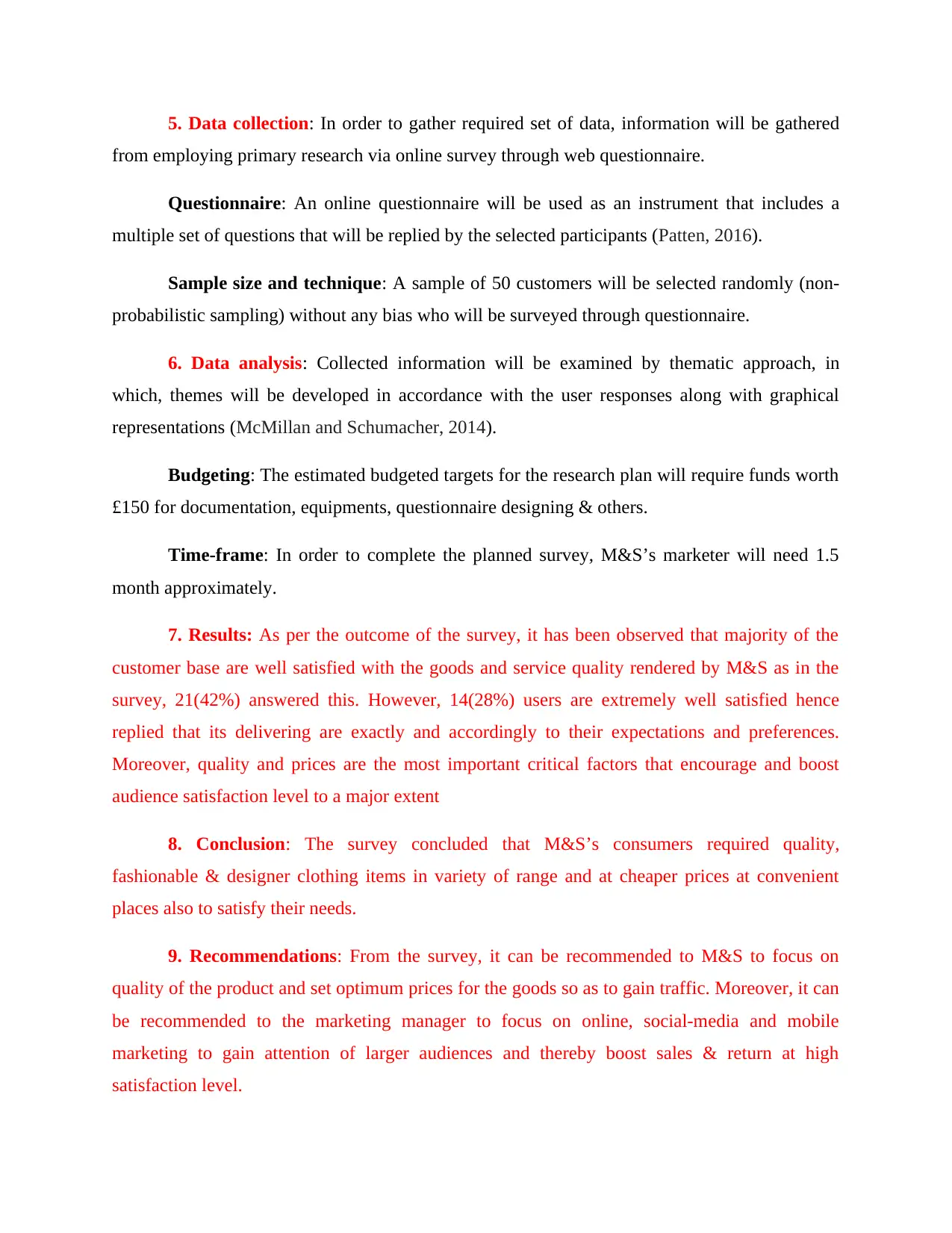
5. Data collection: In order to gather required set of data, information will be gathered
from employing primary research via online survey through web questionnaire.
Questionnaire: An online questionnaire will be used as an instrument that includes a
multiple set of questions that will be replied by the selected participants (Patten, 2016).
Sample size and technique: A sample of 50 customers will be selected randomly (non-
probabilistic sampling) without any bias who will be surveyed through questionnaire.
6. Data analysis: Collected information will be examined by thematic approach, in
which, themes will be developed in accordance with the user responses along with graphical
representations (McMillan and Schumacher, 2014).
Budgeting: The estimated budgeted targets for the research plan will require funds worth
£150 for documentation, equipments, questionnaire designing & others.
Time-frame: In order to complete the planned survey, M&S’s marketer will need 1.5
month approximately.
7. Results: As per the outcome of the survey, it has been observed that majority of the
customer base are well satisfied with the goods and service quality rendered by M&S as in the
survey, 21(42%) answered this. However, 14(28%) users are extremely well satisfied hence
replied that its delivering are exactly and accordingly to their expectations and preferences.
Moreover, quality and prices are the most important critical factors that encourage and boost
audience satisfaction level to a major extent
8. Conclusion: The survey concluded that M&S’s consumers required quality,
fashionable & designer clothing items in variety of range and at cheaper prices at convenient
places also to satisfy their needs.
9. Recommendations: From the survey, it can be recommended to M&S to focus on
quality of the product and set optimum prices for the goods so as to gain traffic. Moreover, it can
be recommended to the marketing manager to focus on online, social-media and mobile
marketing to gain attention of larger audiences and thereby boost sales & return at high
satisfaction level.
from employing primary research via online survey through web questionnaire.
Questionnaire: An online questionnaire will be used as an instrument that includes a
multiple set of questions that will be replied by the selected participants (Patten, 2016).
Sample size and technique: A sample of 50 customers will be selected randomly (non-
probabilistic sampling) without any bias who will be surveyed through questionnaire.
6. Data analysis: Collected information will be examined by thematic approach, in
which, themes will be developed in accordance with the user responses along with graphical
representations (McMillan and Schumacher, 2014).
Budgeting: The estimated budgeted targets for the research plan will require funds worth
£150 for documentation, equipments, questionnaire designing & others.
Time-frame: In order to complete the planned survey, M&S’s marketer will need 1.5
month approximately.
7. Results: As per the outcome of the survey, it has been observed that majority of the
customer base are well satisfied with the goods and service quality rendered by M&S as in the
survey, 21(42%) answered this. However, 14(28%) users are extremely well satisfied hence
replied that its delivering are exactly and accordingly to their expectations and preferences.
Moreover, quality and prices are the most important critical factors that encourage and boost
audience satisfaction level to a major extent
8. Conclusion: The survey concluded that M&S’s consumers required quality,
fashionable & designer clothing items in variety of range and at cheaper prices at convenient
places also to satisfy their needs.
9. Recommendations: From the survey, it can be recommended to M&S to focus on
quality of the product and set optimum prices for the goods so as to gain traffic. Moreover, it can
be recommended to the marketing manager to focus on online, social-media and mobile
marketing to gain attention of larger audiences and thereby boost sales & return at high
satisfaction level.
Paraphrase This Document
Need a fresh take? Get an instant paraphrase of this document with our AI Paraphraser

TASK 3
A. Marketing size trends of M&S’s market
UK retail industry is very dynamic sector, in the last year 2016, continuous rising trends
towards online digitalized technologies brought an inevitable shifting in the retail sector.
Increasing real wages, deflation among non-discretionary items, high spending power, growth in
employment & robust audience confidence bring significant level of growth in the industry
(Retail insight, 2016).
Considering the graph, it can be seen that in the women’s wearing, M&S’s grab larger
share to 9.6% more than Aracdia (7.5%), Next Plc (6.9%), Primark (5.9%) & New Look (3.7%).
It clearly indicates that M&S has good consumer portfolio across all around the globe. It operates
at multinational countries and serve worldwide as it has number of stores in Turkey, Russia,
Ireland, Greece, Finland, India, Spain, Hungary and other nations. It focuses towards delivery of
superb quality products to gain audience traffic and better yield.
A. Marketing size trends of M&S’s market
UK retail industry is very dynamic sector, in the last year 2016, continuous rising trends
towards online digitalized technologies brought an inevitable shifting in the retail sector.
Increasing real wages, deflation among non-discretionary items, high spending power, growth in
employment & robust audience confidence bring significant level of growth in the industry
(Retail insight, 2016).
Considering the graph, it can be seen that in the women’s wearing, M&S’s grab larger
share to 9.6% more than Aracdia (7.5%), Next Plc (6.9%), Primark (5.9%) & New Look (3.7%).
It clearly indicates that M&S has good consumer portfolio across all around the globe. It operates
at multinational countries and serve worldwide as it has number of stores in Turkey, Russia,
Ireland, Greece, Finland, India, Spain, Hungary and other nations. It focuses towards delivery of
superb quality products to gain audience traffic and better yield.
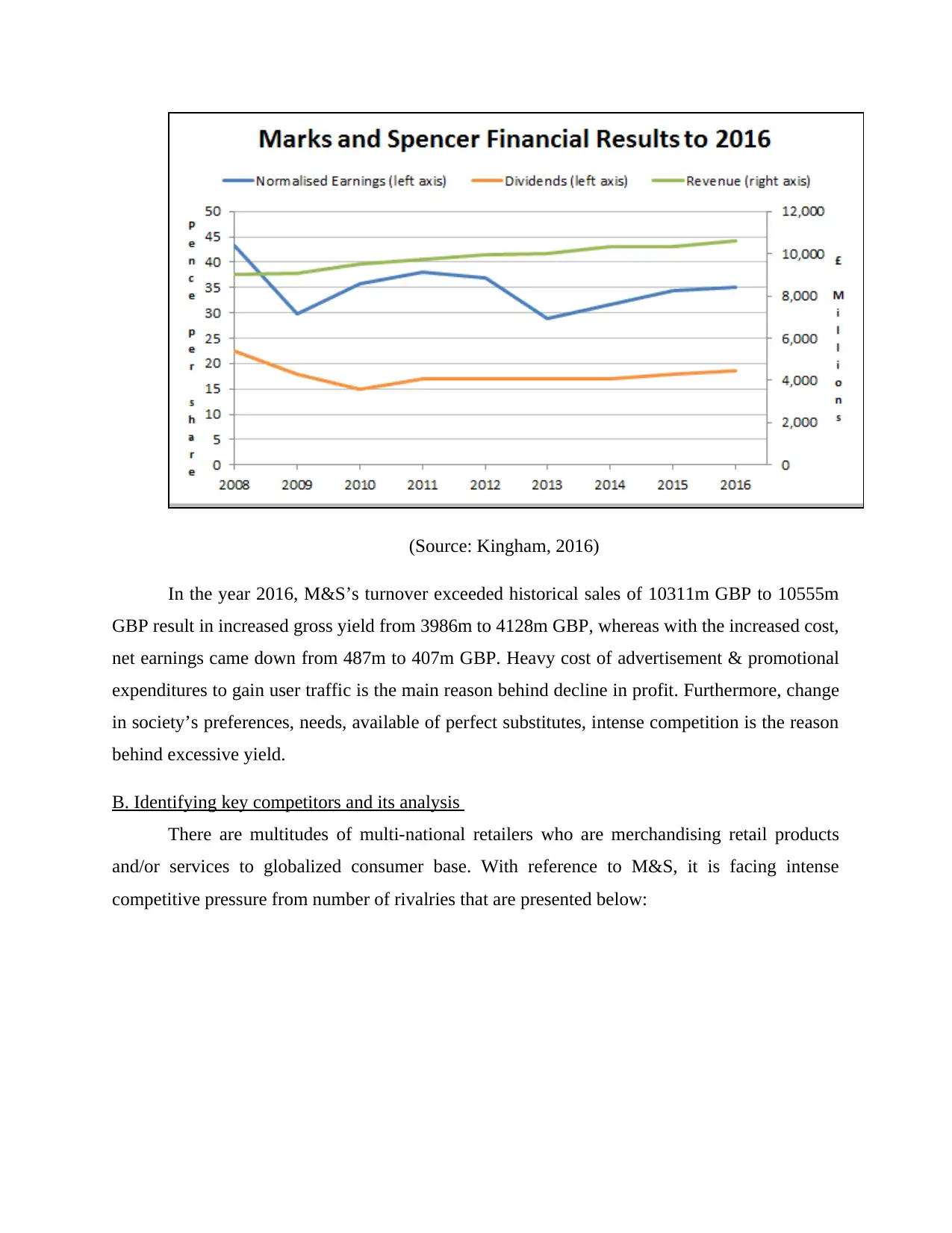
(Source: Kingham, 2016)
In the year 2016, M&S’s turnover exceeded historical sales of 10311m GBP to 10555m
GBP result in increased gross yield from 3986m to 4128m GBP, whereas with the increased cost,
net earnings came down from 487m to 407m GBP. Heavy cost of advertisement & promotional
expenditures to gain user traffic is the main reason behind decline in profit. Furthermore, change
in society’s preferences, needs, available of perfect substitutes, intense competition is the reason
behind excessive yield.
B. Identifying key competitors and its analysis
There are multitudes of multi-national retailers who are merchandising retail products
and/or services to globalized consumer base. With reference to M&S, it is facing intense
competitive pressure from number of rivalries that are presented below:
In the year 2016, M&S’s turnover exceeded historical sales of 10311m GBP to 10555m
GBP result in increased gross yield from 3986m to 4128m GBP, whereas with the increased cost,
net earnings came down from 487m to 407m GBP. Heavy cost of advertisement & promotional
expenditures to gain user traffic is the main reason behind decline in profit. Furthermore, change
in society’s preferences, needs, available of perfect substitutes, intense competition is the reason
behind excessive yield.
B. Identifying key competitors and its analysis
There are multitudes of multi-national retailers who are merchandising retail products
and/or services to globalized consumer base. With reference to M&S, it is facing intense
competitive pressure from number of rivalries that are presented below:
⊘ This is a preview!⊘
Do you want full access?
Subscribe today to unlock all pages.

Trusted by 1+ million students worldwide
1 out of 21
Related Documents
Your All-in-One AI-Powered Toolkit for Academic Success.
+13062052269
info@desklib.com
Available 24*7 on WhatsApp / Email
![[object Object]](/_next/static/media/star-bottom.7253800d.svg)
Unlock your academic potential
Copyright © 2020–2025 A2Z Services. All Rights Reserved. Developed and managed by ZUCOL.





